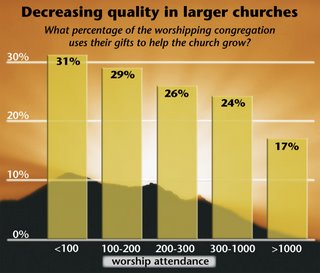
How do you measure excellence in a local church? If you have a cool gig on Sunday, a flash-driven website, and mailers that proclaim that you are not as boring as other churches, does that mean that you are a quality church?
Ask yourself, “Why do we exist on planet earth?” If the answer is to make disciples of Jesus Christ, then your standard of evaluation should reflect that. One measure of discipleship is the use of spiritual gifts. NCD* research indicates that small churches tend to provide more opportunities for followers of Jesus to use their spiritual gifts on a regular basis than larger churches.
Does this mean that megachurches are bad? Not at all, it simply means that large churches have to work harder not to let people slip through the cracks. However, we need to take a strategic look at intentionally planting more small churches. Starting small, indigenous churches that are intentional about reproducing themselves is the missional strategy of the SBC International Mission Board and many other mission organizations. These organizations are reporting exponential gospel expansion in various hot spots around the world as the result of small church multiplication. Meanwhile, North America remains the only continent in the world where the gospel is not spreading.
Over the past 40 years, our focus has been on church growth. Success was determined by size. Our bigger is better thinking has left many small churches with an inferiority complex. I’ve even met some folks who would declare small churches illegitimate- the solution being to shut them all down and combine them with larger churches.
Granted, many small churches are struggling just to survive and most have not reproduced themselves. But, let’s not overlook the value of helping these churches to develop a missional paradigm and encouraging them to reproduce themselves into even smaller segments. And let’s not forget to encourage large churches to value their smaller siblings and to consider starting a few themselves.
I am interested in your thoughts…
*The Institute for Natural Church Development spent the past ten years researching church health and growth in 70 countries and 40,000 churches.
